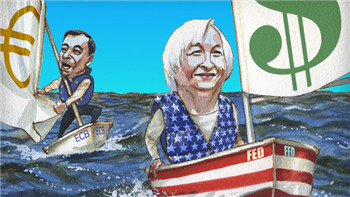
The European Central Bank eased monetary policy last week, albeit not enough to please markets. But the US Federal Reserve is widely expected to raise short-term rates next week. This divergence between the most important central banks is likely to prove significant. Does this make sense for each in view of their own mandates? And what complications might such a divergence create for the world?
欧洲央行(ECB)最近放松了货币政策,尽管还不足以取悦市场。但市场普遍预期美联储(Fed)即将提高短期利率。全球最重要的这两家央行的这种政策差异可能被证明意义重大。这对它们各自的使命有道理吗?这种差异可能给世界带来哪些复杂局面?
At first glance, the answer to the first question is straightforward: yes. The Fed and the ECB ought to be following different policies because their economies are in such widely different places.
乍看之下,第一个问题的答案显而易见:有道理。美联储和欧洲央行应该出台不同的政策,因为它们所在的经济体处于截然不同的位置。
As Janet Yellen, Fed chair, pointed out last week, the US economy has enjoyed a sustained recovery since the Great Recession. The unemployment rate has declined from a post-crisis peak of 10 per cent to 5 per cent. The annual rate of core consumer price inflation — excluding food and energy — is also close to (though below) the target of 2 per cent. It seems reasonable, given all these facts, to argue that the US economy is both growing at well above potential rate and is close enough to full employment for tightening to begin.
正如美联储主席珍妮特耶伦(Janet Yellen)最近指出的那样,美国经济自“大衰退”以来持续复苏。失业率从危机后的10%的峰值降至5%。剔除食品和能源的核心消费价格指数(CPI)也接近(尽管低于)2%的目标。鉴于所有这些事实,我们似乎有理由说,美国经济正以远高于潜在增长率的速度增长,而且足够接近充分就业,启动收紧的条件已经具备。
The eurozone is in a very different place, as Mario Draghi, ECB president noted in another significant speech in New York last week. The eurozone has not enjoyed a strong recovery from the Great Recession and the subsequent eurozone recession. On the contrary, in the second quarter of this year, real domestic demand was still 3.5 per cent lower than pre-crisis. From its peak of 12.1 per cent in early 2013, the unemployment rate has fallen only to 10.8 per cent. As Mr Draghi stressed, the ECB is failing to achieve its mandate of price stability, as it defines it: a rate of CPI “ but close to, 2 per cent”. In October, year-on-year core CPI was just 1.1 per cent and the headline rate just 0.1 per cent. Indeed, year-on-year core inflation in the eurozone has been below 2 per cent since March 2013. (See charts.)
欧元区的情况则截然不同,正如欧洲央行行长马里奥德拉吉(Mario Draghi)最近在纽约所做的重要演讲中指出的那样。欧元区没有从“大衰退”以及随后的欧元区衰退强劲复苏。相反,在今年第二季度,欧元区实际内需水平仍比危机前低3.5%。失业率从2013年初12.1%的峰值仅仅降至10.8%。正如德拉吉强调的那样,欧洲央行未能实现价格稳定的使命——它对价格稳定的定义是:CPI“低于但接近2%”。今年10月,核心CPI指数同比仅上涨1.1%,整体CPI仅上涨0.1%。实际上,自2013年3月以来,欧元区核心通胀率同比一直低于2%(见图表)。
To deliver on their mandates the central banks ought to be behaving differently. But this does not mean what they are about to do is right. This is partly their mandates are different. It is also because both are too conservative.
为了完成各自的使命,这两家央行应该出台不同的政策。但这并不意味着它们即将做的事情是正确的。这在一定程度上是因为它们的使命不同,也因为它们都过于保守。
First, the Fed. Here are four reasons why the case against raising rates is still strong. First, there is no sign of significant inflationary pressure; the strength of the dollar will also keep inflation in check. Second, if the Fed were pursuing a symmetrical policy, inflation should be above 2 per cent as much as below. In fact, core inflation has been below 2 per cent most of the time since the end of 2008. Third, there is a real risk that the tightening will have a bigger negative effect on the economy than expected, particularly if it is seen as the first of many moves (however gradual). Given this, there is a substantial risk that the interest rate will be brought back hard against the zero lower bound in the next (possibly quite imminent) recession.
先说美联储。4个反对加息的理由仍然很充分。首先,没有迹象表明存在显著通胀压力,同时美元强势也遏制了通胀。第二,如果说美联储实施了对称政策,那么通胀应该时而高于、时而低于2%。实际上,自2008年末以来的大部分时间里,核心通胀率一直低于2%。第三,一个切实的风险是,收紧对经济的负面影响将超过预期,尤其是如果它被视为多次收紧的第一步(无论怎么渐进)。鉴于此,一个重大风险是,利率将在下一场衰退(可能很快就会来临)中猛然下调至零下限。
Last and most important, while unemployment is low, so is the participation rate. There is a good chance that, if the economy is run “hot”, more workers will be pulled into the labour force. It is possible, too, this would accelerate investment and productivity growth, keeping inflation in check. So the risks of tightening exceed those of waiting.
最后也是最重要的是,尽管失业率保持低位,但参与率同样不高。如果让经济在“高温”下运行,更多工人很可能被拉到劳动力大军里。同样可能的是,这将加速投资和生产率增长,遏制通胀。因此收紧的风险超过等一等的风险。
Some will argue that delay risks further destabilising the financial system. This view is problematic. If the monetary policy that stabilises supply and demand in the real economy destabilises the financial system, the problem lies in the latter. It must be dealt with forcibly and directly.
一些人将会辩称,推迟加息有可能进一步破坏金融体系的稳定。这种观点存在问题。如果稳定实体经济供需的货币政策破坏了金融体系的稳定,那么问题出在后者。必须有力而直接地解决这个问题。
The ECB, meanwhile, disappointed the markets. This is not of itself important; its job is not to please markets but to stabilise the eurozone economy. Still, it merely lowered the deposit rate 10 basis points, extending quantitative easing at an unchanged 60bn a month, by six months, to March 2017. This simply does not qualify as decisive action.
与此同时,欧洲央行让市场感到失望。这本身并不重要;欧洲央行的工作不是取悦市场,而是稳定欧元区经济。话虽如此,欧洲央行只是将存款利率下调10个基点,将每月600亿欧元的量化宽松计划延长6个月,至2017年3月,但规模不变。这确实算不上果断的行动。
In his New York speech, Mr Draghi seemed to recognise this. He made three fundamental points. Today’s aggressive policies are working; the loosening last week was significant; and “There cannot be any limit to how far we are willing to deploy our instruments, within our mandate, and to achieve our mandate.” The points are reasonable. Even so, the ECB should have announced it will continue with QE until it hits its inflation goal. The unnecessary weakness of the eurozone economy has gone on too long.
德拉吉在纽约的演讲中似乎认识到了这一点。他提出3个根本观点:如今的激进政策正在见效;最近的政策放松规模可观;以及“我们在使命范围内动用政策工具以履行使命的意愿是没有限度的”。这些观点是合理的。即便如此,欧洲央行本应宣布将继续量化宽松直至达到通胀目标。欧元区经济的不必要疲弱已经持续太久了。
Whatever the drawbacks of the decisions of the two central banks, the big picture is clear. The US is years ahead of the eurozone in its recovery and is, in consequence, at a different stage of the monetary policy cycle. It is likely the divergence will increase modestly in the next few years. The Fed is also likely to diverge increasingly from the Bank of Japan, which will remain ultra-loose, and the People’s Bank of China, which is loosening (albeit from a tighter starting point). To return to the question of the potential complications of such a divergence, it is likely to reinforce the strength of the dollar, which in turn, would worsen the difficulties of dollar-denominated borrowers. Yet it would also be risky to extrapolate the divergence too confidently. The Fed may find the US economy is not as strong as it believes, particularly given the strength of the dollar. If so, the tightening might be small and brief.
无论这两家央行的决定有什么不足,大格局是显而易见的。美国在复苏轨道上超前欧元区几年,因而处于货币政策周期的不同阶段。这种差异很可能在今后几年温和加大。美联储与日本央行(BoJ)和中国央行的政策分歧也可能越来越大——日本央行将保持超级宽松政策,而中国央行正在放松政策(尽管是从偏紧的起点开始)。回到上面的问题,即这种差异可能带来哪些复杂局面,它可能让美元更加强势,进而加剧以美元计价的借款人的困难。然而,过于自信地外推这种差异也是有风险的。美联储可能发现美国经济不像其认为的那么强劲,尤其是考虑到美元的强势。若果真如此,美国的收紧可能是小幅和短暂的。
While good reasons do exist for the divergence, experience reminds us of the danger of overconfidence. The BoJ has now had near-zero short-term rates for two decades. It also raised rates, modestly, in 2000 and in 2006 and 2007. It was forced to reverse. The Fed should note this sobering precedent.
尽管美国和欧元区的政策差异的确有很好的理由,但经验提醒我们,自信过头是有危险的。日本央行实行接近于零的短期利率已有近20年。它也曾在2000年、2006年和2007年温和加息,随后被迫逆转政策。美联储应该留意这种令人警醒的先例。












